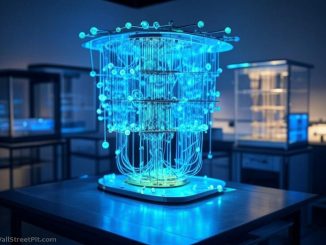- Amazon’s Ocelot quantum chip, unveiled Thursday, features a 14-component design with five cat qubits across two 1cm² silicon microchips, aiming to cut error correction costs by a whopping 90% and reduce resources to one-fifth of current approaches, per AWS’s Oskar Painter.
- The chip’s scalable architecture, detailed in a Nature paper, uses Tantalum oscillators to boost efficiency, potentially speeding practical quantum computing by five years.
- AWS claims Ocelot’s error-resistant cat qubits – five data, five buffer, four error-detection – could reshape quantum’s future, contrasting Nvidia’s 15-30 year and Meta’s 10-year timelines, building on Amazon’s 2021 Braket platform launch.

Amazon’s unveiling of Ocelot, its first quantum computing chip, on Thursday marks a pivotal stride in the race toward fault-tolerant quantum systems, with AWS’s Oskar Painter touting its potential to slash error correction costs by up to 90% and accelerate practical quantum computing by as much as five years, leveraging a design that demands one-fifth the resources of rival approaches. The Ocelot prototype, forged at the AWS Center for Quantum Computing at Caltech, stacks two 1cm² silicon microchips layered with superconducting materials like Tantalum, integrating five cat qubits – named for Schrödinger’s thought experiment – five buffer circuits, and four error-detection qubits into a scalable architecture that curbs errors natively, a breakthrough detailed in a Nature paper. Shares of Amazon (AMZN) remained flat, trading around the $214 level amid this reveal, which trails Microsoft’s (MSFT) quantum chip debut last week, spotlighting a tech rivalry where quantum bits, or qubits, promise to tackle problems beyond classical computers’ reach by existing in dual states simultaneously.
The Ocelot’s cat qubit design, bolstered by high-quality Tantalum oscillators, intrinsically suppresses errors, a leap over traditional methods that AWS claims could shrink quantum computing’s resource footprint – Painter’s vision pegging future chips at one-fifth the cost of current setups – while its microelectronics-inspired fabrication hints at mass production potential. Nvidia (NVDA) CEO Jensen Huang’s January forecast of 15 to 30 years for useful quantum systems and Meta’s (META) Mark Zuckerberg’s decade-plus timeline to Joe Rogan contrast with Painter’s bolder outlook, where Ocelot’s 90% cost reduction in error correction could hasten that horizon by five years, though its 14 components – five data qubits, five buffers, and four error qubits – remain a prototype far from commercial scale. Amazon’s move builds on its quantum toehold via AWS’s Braket service, launched in 2021, now poised to test Ocelot’s successors, positioning it against Microsoft’s Azure quantum offerings in a field where error correction remains the linchpin.
Ocelot’s two-chip stack, electrically bonded and etched with superconducting circuits, reflects AWS’s bet on efficiency over qubit count – its five cat qubits and supporting elements dwarfed by the million-qubit dream for practical use – yet its 90% error correction savings and scalable blueprint signal a quantum future less resource-intensive than peers’. The Nature paper cements this as a scientific milestone, with Tantalum’s steady oscillators powering the cat qubits’ dual-state storage, a design that sidesteps the error-prone bulk of classical approaches and aligns with rising industry focus on fault tolerance. Amazon’s quantum gambit, marrying a lean 1cm² footprint with a cost-cutting ethos, pitches Ocelot as a catalyst – potentially five years ahead of the 15-to-30-year curve Huang and Zuckerberg foresee – though its real-world impact hinges on scaling those 14 components into a transformative system.
WallStreetPit does not provide investment advice. All rights reserved.
- Bulenox: Get 45% to 91% OFF ... Use Discount Code: UNO
- Risk Our Money Not Yours | Get 50% to 90% OFF ... Use Discount Code: MMBVBKSM
Disclaimer: This page contains affiliate links. If you choose to make a purchase after clicking a link, we may receive a commission at no additional cost to you. Thank you for your support!




Leave a Reply